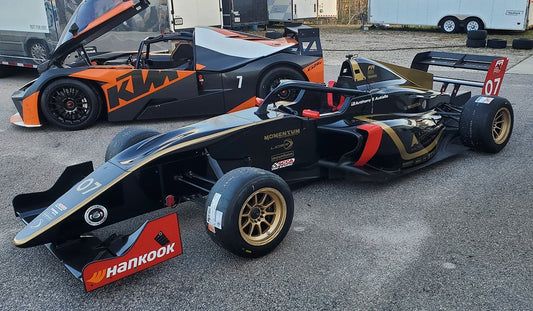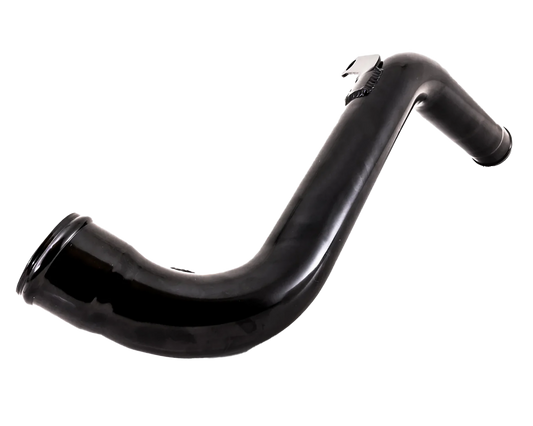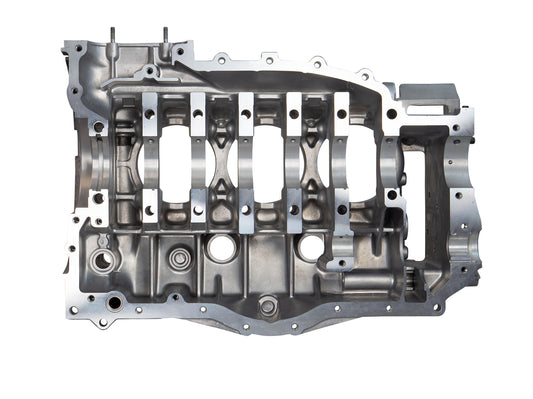Background
Ever since the Mk3 Focus RS came out in 2016, Mountune USA has been pushing the performance boundaries of the Ford EcoBoost 2.3L 4-cylinder engine. The Mountune MRX turbocharger upgrade, featuring the Borg Warner EFR-7163 turbocharger, makes an extremely responsive 500+ hp Focus RS attainable, and holds records on the road course and the drag strip. If an all-out horsepower number were the goal a larger turbo could be sized to theoretically make just about any level of horsepower desired, at the expense of more turbo lag. With Mountune USA engine upgrades from intake to tail pipe maximizing the airflow through the 2.3L EcoBoost engine and the Mountune USA forged internal engine program providing a stout foundation, that left the fuel delivery system as the last major area to address in the search for horsepower.
It is all about time - fuel injection time to be exact.
With advances in turbocharging and electronic fuel injection over the past 10-15 years, 4-cylinder engine performance has received a real boost. It’s not uncommon to see 1,000+ horsepower Mitsubishi 4G63 or Honda 4-cylinder engines these days. Build a stout engine foundation, cram boost into it with a huge turbocharger, match it with the corresponding ratio of fuel, and ignite it. Do that frequently enough and the torque produced can generate over 1000 hp at 9000+ RPM.
The table below lists the engine cycle time in milliseconds for various engine speeds. For reference, a blink of the human eye takes about 100 milliseconds. Remember an engine cycle is two full revolutions of the crankshaft in a 4-stroke engine. Needless to say, things are happening very rapidly inside of a 4-stroke internal combustion engine!

In a port fuel injected engine, the fuel injector can essentially spray at any time during the engine cycle. The air and fuel collect behind the intake valve and are both sucked into the cylinder together when the camshaft opens the valve. Aftermarket support for port fuel injection has matured over the years to the point where fuel injectors are available in various flow rates to support all but the most extreme horsepower requirements. Even in extreme cases, it is fairly easy to add a second (and sometimes third!) set of injectors to the intake ports.
Gasoline direct injection (GDI) engines on the other hand pose some significant challenges to making large amounts of horsepower. The biggest challenge is time, or lack thereof. Because fuel is being introduced directly into the combustion chamber, there are times in the 4-stroke engine cycle where you absolutely cannot safely inject fuel. In general, fuel can be injected into the combustion chamber during the intake stroke and part way into the compression stroke. This essentially leaves a maximum window of somewhere around 35-40% of an engine’s cycle for injection. That 20ms of cycle time at 6000 rpm effectively only leaves about 8ms available for fuel injection on a GDI engine.
Working With What You Have
To overcome the challenges of injecting directly into the combustion chamber in a very short amount of time, GDI fuel systems operate at very high pressures. The Ford EcoBoost engines run a maximum of 200 bar (~3000 psi). This high pressure is generated by a high pressure fuel pump (HPFP) that is mounted to the cylinder head and directly driven by the camshaft. In the case of the 2.3L EcoBoost engine, there are four lobes on the fuel pump drive. This means that the fuel pump piston and spring are compressed four times for every engine cycle as opposed to only one time like the intake and exhaust valves.

During low load situations where the throttle is closed like at idle, a very small amount of fuel is required to match the corresponding air in the combustion chamber. All fuel injectors have a minimum usable opening time to inject the fuel. If there were a full 3000 psi behind the injector at idle, it would inject far too much fuel even with the injector’s minimum open time. To reduce the amount of fuel injected, the GDI pressure is controlled via a solenoid valve integral to the HPFP. This valve is actuated by the ECU and controls how much fuel is drawn into the pumping chamber, which in turn determines the resulting GDI system pressure. This target pressure is continuously variable throughout the engine’s operating range.
The GDI fuel injectors themselves are unique in that they are very fast reacting and high flowing (when compared to traditional port fuel injectors). The ECU boosts the battery voltage up from the normal 12V to minimize the response time and open against extreme fuel pressures. They are sized small enough so they can properly meter the fuel required at idle with a reasonable open time, while also having a high enough flow rate to make the stock Focus RS’s 350 hp at higher boost levels.
Every component of this GDI fuel system is sized around the fueling needs of a stock 350 hp / 350 lb-ft Focus RS running on gasoline. Once you start increasing boost or running E85 fuel (which requires 35-40% more fuel flow than gasoline), there is very little headroom left in the GDI fuel system.
Extreme Times Call for Xtreme-DI Solutions
To increase fuel delivery to GDI engines, the easy way out had historically been to install a set of port fuel injectors. Tuners would install a port-injector adapter flange or sometimes a custom intake manifold to put four additional fuel injectors in the intake manifold runners. The problem lies in how these injectors are to be controlled. The proper way to do it would be to run a Syvecs full standalone racing ECU to blend in the port injectors appropriately. Unfortunately, this is cost prohibitive for many customers. The other way to run them was to wire in a piggyback fuel injector controller. Mountune USA strongly recommends against going this route, as they are antiquated 1990’s technology that have absolutely zero interface with the ECU that is controlling the rest of the engine. Many of the installations we’ve seen involve wiretaps on critical engine sensors and other unsavory wiring practices. That is just not a proper (or reliable) way to precisely control a critical amount of additional fuel into your engine.
Mountune USA realized that the key to widespread EcoBoost modification would be an upgraded GDI fuel system that could support in excess of 500 hp (on ethanol blended fuels) and run properly on a reflashed OEM ECU for full control, reliability, and OEM diagnostics. Mountune USA teamed up with the GDI experts at Xtreme-DI and embarked on a two-year development journey to arrive at the ultimate Ford EcoBoost GDI upgrade solution.
The first component out of the gate was the HPFP-35 High Pressure Fuel Pump Upgrade. Because the HPFP piston is driven by the camshaft relative to engine speed, a simple piston bore change in the pump would increase the available fuel delivery volume by 35%. With this came a bit of mechanical adaptation along with some tweaks to the ECU’s drive signal, all programmable in the OEM ECU via the COBB AccessPort.
With abundant high pressure fuel supply to the rail, we still had the challenge of injection time. We needed to come up with a high-flowing GDI fuel injector that retained the spray pattern, response time, ECU driver current requirements, and reliability of the OEM injectors. It was a challenge to balance the low flow requirements of idling cleanly on gasoline against the high flow requirements of supporting 500+ horsepower on E85. Several prototype GDI injector sets were tested- some flowed too little, some flowed too much. Other prototypes proved to be too costly and/or unreliable. We tailored the flow rate, spray pattern, and manufacturing method to finally arrive at the +50% High Flow Direct Injection Fuel Injector Upgrade. Uncharted Territory
Uncharted Territory
Mountune USA was already well into the 2.3L Ford EcoBoost engine development as seen in the Fastest Focus RS in the World. That car’s development had taken place over a couple years, and had gone through several different fuel system and engine management variations. The first order of business was to switch that engine over to a full GDI-only system and match the previous best performance on E85 fuel. That went about as well as expected with such a thoroughly tested and developed GDI fuel upgrade system, pretty uneventful to be honest.
With our goals being reached on E85 as we originally set out to do, we realized that actually left us with ~35% more fuel flow available if we were to lower the ethanol content and get closer to a high octane racing gasoline. Back to the Mountune USA Superflow SF-902S engine dyno we went. This time with a larger Borg Warner EFR-8374 turbocharger and E30 (30% ethanol fuel). After a bit of tuning on the Syvecs S-GDI4 ECU, the result was 684 hp and 561 lb-ft of torque.
Why don’t we go for 1000+ hp like those Mitsubishi 4G63’s and Honda B18’s? Even though we have now vastly increased the fuel delivery capacity of the Ford EcoBoost 2.3L’s GDI fuel system, we still feel a 1000 hp direct-injected 4-cylinder engine is an extremely tall order. In small displacement 4-cylinder engines, high RPM is a big part of the horsepower equation. Horsepower is a calculation of torque and RPM: (Torque * RPM) / 5252 = Horsepower. So a 1000 horsepower engine would be making 525 lb-ft at 10,000 RPM, or 583 lb-ft at 9,000 RPM.
With our 2.3L Ford EcoBoost engine making 561 lb-ft, we are already in that ballpark for peak torque. The problem is that GDI engines are not going to be able to turn RPM much past their original OEM limits. Part of that is due to the diminishing amount of time available for fuel injection with increasing RPM. There is no way to get a second injector into the combustion chamber to inject more fuel in that shorter amount of time. More importantly, there are mechanical limitations. Recall that the HPFP is driven by the camshaft at a rate of four times per engine cycle. Increasing the engine’s rev limit puts greater stress on the HPFP piston and spring. With the intake and exhaust valves turning 7,000 RPM, that’s like asking your HPFP piston and spring to turn 28,000 RPM! The mechanical components of the HPFP are not made to run at those frequencies, not to mention that the HPFP’s integral solenoid valve cannot electrically react fast enough to control the fuel into the pumping chamber.
If we were to make 1000 hp at 7,000 RPM, that would require 750 lb-ft of torque. That’s not likely to happen in production-based cylinder head and block castings without splitting the block in half. So for now, we will be happy with only 683 horsepower and 561 lb-ft out of our little Ford EcoBoost 2.3L 4 -cylinder engine. We will continue development to push the envelope and stay at the forefront of gasoline direct injected, turbocharged, small-displacement 4-cylinder engines like the Ford Ecoboost 2.0/2.3L and the Honda K20C1.




